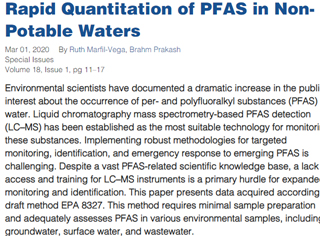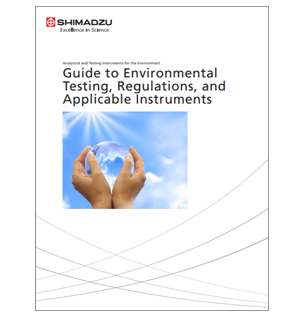Analysis of Per- and Polyfluoroalkyl Substances (PFAS)

Analysis of PFAS in Drinking Water and Environmental Matrices
Per-and polyfluoroalkyl substances (PFAS) are a group of persistent and harmful chemicals that can be commonly found in the environment globally. These anthropogenic chemicals can come from various sources such as manufacturing, industrial applications, food contact materials and consumer products, and eventually end up and accumulate in the water, soil and living organisms. With concerns rising quickly about the health risks associated with PFAS exposure, it is important to ensure proper monitoring of these chemicals.
PFAS, primarily PFOA and PFOS, have been included in the monitoring list of drinking water contaminants in many countries such as US, Europe, Australia and several parts of Asia (e.g. China and Singapore). Not only that, an increasing number of regulatory agencies and research institutes all over the world are expanding their scope of monitoring to a longer list of PFAS and other environmental matrices such as non-potable waters and soil. Sampling procedures and analytical methods for the analysis of PFAS in these matrices are therefore required to be standardized to ensure proper and accurate determination of PFAS.
There are several methods, such as US EPA, ASTM and other standard methods, established for PFAS. In June 2019, US Environmental Protection Agency (US EPA) have validated EPA Method 8327 for the determination of 24 PFAS in groundwater, surface water, and wastewater matrices using LC-MS/MS. With the published draft SW-846 Method 8327, Shimadzu LC-MS/MS have been demonstrated to meet and exceed the specified criteria; Accordingly, PFAS testing laboratories can easily update their workflow for easy implementation.
Watch this short animatic to learn more on PFAS and how Shimadzu can help in your PFAS analysis.
Interested to know more about the latest developments and solutions for PFAS analyses?
Watch our on-demand webcast!
This webcast will discuss the global trends and regulatory requirements pertaining to PFAS analyses (e.g. EPA 537.1 and EPA 8327). Several case studies on drinking water and environmental matrices will be described to illustrate the difficulties and pitfalls of LC-MS/MS analyses and their solutions.
Resources on PFAS Analysis
Shimadzu’s LC-MS/MS Methods for PFAS Analysis in Environmental Matrices
![]()
Shimadzu support environmental testing and research laboratories and provide you with LC-MS/MS technologies best suited for your PFAS testing needs. By working closely with regulatory bodies, Shimadzu stays up-to-date with the latest developments (e.g. EPA Method 537.1 and EPA Method 8327) and vetted several LC-MS/MS methods for PFAS analysis. A variety of resources are created to help you kick-start or modify your PFAS analysis using easy-to-use, low-cost and robust solutions
Applications for Drinking Water
- Latest! [App News] Analysis of Per- and Polyfluoroalkyl Substances (PFAS) Specified in EPA M537.1 Using the Triple Quadrupole LCMS-8045
- [Pittcon 2020 Poster] Are You Sticking with Drinking Bottled Water? Assessment of PFAS Content in Commercial Samples
- Analysis of PFAS Specified in EPA Method 537 & Beyond using Shimadzu UFMS™
- [ASMS 2019 Poster] Analysis and Quantitation of Polyfluorinated Alkyl Substances (PFAS) in EPA Method 537.1 Using High Resolution Accurate Mass Spectrometry (HRAM)
Application for Environmental samples
- Latest! [App News] Analysis of PFAS Compounds in Fish Tissue Using Offline Supercritical Fluid Extraction and LC-MS/MS
- [App News] Analysis of PFAS Specified in EPA M8327 using the LCMS-8050 Triple Quadrupole MS
- [White Paper] Ultra-Fast LC-MS/MS Analysis of PFAS in Environmental Samples
- [Pittcon 2020 Poster] Analysis of PFAS in Non-Drinking Water Matrices Using the LC-Triple Quadrupole MS
- [ASMS 2019 Poster] The PFAS Conundrum: Mass Spectrometry Solutions for Addressing It
- [ASMS 2019 Poster] Ultra-Fast Trace Quantitation of PFAS in Drinking and Environmental Waters Using an Automated Sample Preparation and LC-MS/MS System
- [ASMS 2018 Poster] Improved Analysis of PFAS in Environmental Samples Using Optimized ASTM Method 7968/7979
Targeted and Untargeted Screening using QTOF (LCMS-9030)
Textiles
- [Technical Report] Analyses of PFOS and PFOA Precursors in Textile Products Using EI-MRM and PCI-SIM Method
- [ASMS 2016 Poster] A Fast LC-MS/MS Method for High Sensitivity Determination of 26 PFCs in Textiles
- [ASMS 2016 Poster] Development of Automated Screening and Quantitation Approach on Novel On-Line SFE-SFC-MS/MS Platform for 23 Restricted PFCs in Textiles
- LC-MS/MS Method Package for Restricted Chemicals in Textiles – For LabSolutions™ LCMS
Other PFAS Materials
[Poster] PFAS Methods Compilation
[LCGC Article] Rapid Quantitation of
PFAS in Non-Potable Water
[Infographic] A Complete One-Stop Solution for PFAS Analysis
Other Links on PFAS
Find additional useful information and resources from regulatory and other stakeholders.
Additional Resources on Environmental Analysis
With our dedication in improving and protecting the environment, Shimadzu has been specializing in the development and usage of instruments for environmental analysis for decades. We achieve a new global standard in chromatography, mass spectrometry and spectroscopy techniques and offers a better solution for environmental applications. Refer to our compilation of environmental resources for more information.
Related Product






![[E-Book] Best Practices for Optimizing PFAS Analysis](/sites/shimadzu.co.kr/files/d7/ckeditor/an/industry/environment/pfas/e-book_a.jpg)
![[Infographic] A Complete One-Stop Solution for PFAS Analysis](/sites/shimadzu.co.kr/files/d7/ckeditor/an/industry/environment/pfas/info.jpg)


